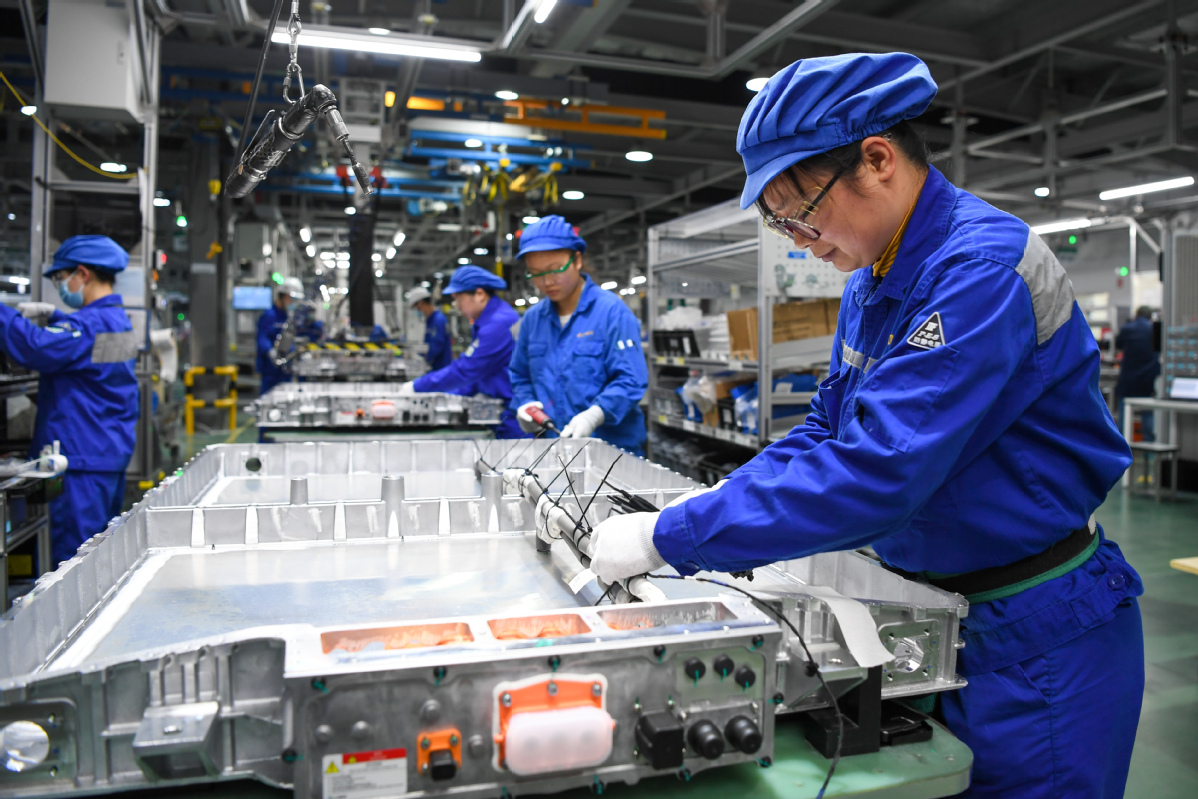Innovation opens new doors for country's exports
Cutting-edge technologies, sustainable solutions move to forefront over conventional goods
Early last month, work began on closing the hull of an offshore wind turbine installation vessel at a shipyard owned by a company in Yantai, Shandong Province.
Yantai CIMC Raffles Ocean Technology Group has seen a notable increase in orders for this type of vessel since last year, with six of them currently under construction, accounting for one-third of its total orders.
Wei Chuntao, director of the company's supply chain management center, said: "These vessels, which can each lift 3,000 metric tons, are being built for a Dutch shipowner. They are high-end ships and cost much more than bulk ships and small and medium-sized container vessels."
The technical specifications for these vessels, such as lifting capacity and operational water depth, have been upgraded to meet clients' demands, Wei added.
Chen Bin, deputy director of the expert committee at the China Machinery Industry Federation, which is based in Beijing, said that Chinese products have benefited from continued improvements in technological capabilities and the advancement of industrial transformation and upgrading.
In particular, technology-intensive green products and those with long industrial chains, such as electronics, liquefied natural gas carriers and construction machinery, will drive the nation's exports this year, Chen added.
For example, there has been a significant increase in global demand for offshore wind installation vessels, with Chinese shipyards securing nearly 90 percent of the resulting manufacturing orders. As of October, 37 orders had been placed worldwide for such vessels, with Chinese shipyards responsible for building 33 of them, data from the China Association of the National Shipbuilding Industry show.
Ming Ming, chief economist at CITIC Securities, said that even though the current global economic landscape is characterized by persistently low levels of exports, consumption and investment demand among major economies, China's export sector has capitalized on its ability to adapt and diversify its product offerings.
Chinese manufacturers have demonstrated agility in identifying emerging market trends and adjusting their production to match them, Ming said.
Peng Bo, a researcher specializing in foreign trade at the Chinese Academy of International Trade and Economic Cooperation in Beijing, said: "It is crucial to recognize the emerging opportunities. China's foreign trade is undergoing a transition from rapid growth to focus on high-quality expansion."
Highlighting the ongoing optimization of the nation's foreign trade structure, the gradual reinforcement of new trade momentum, and the effective implementation of stable foreign trade policies, Peng said technology-intensive green products have emerged as a vital growth driver for China's exports.
At the annual Central Economic Work Conference in Beijing last month, Chinese leaders stressed that among the top priorities for this year, efforts should be made to foster new drivers of foreign trade, consolidate the overall performance of foreign trade and foreign capital, and expand intermediate goods trade, services trade, digital trade and cross-border e-commerce exports.
Gao Lingyun, a researcher at the Institute of World Economics and Politics, which is part of the Chinese Academy of Social Sciences, said traditional exports such as clothing and furniture are being replaced increasingly by high-tech innovations in fields such as new energy and advanced manufacturing.
This shift marks a significant transformation in the export landscape, where cutting-edge technologies and sustainable solutions are moving to the forefront over conventional goods, Gao added.
The strong export performance of the "new three" — electric vehicles, lithium batteries, and solar cells — has maintained double-digit growth for 14 consecutive quarters, with a year-on-year rise of 41.7 percent to 798.99 billion yuan ($111.82 billion) in the first three quarters of last year, data from the General Administration of Customs, or GAC, show. These exports accounted for 4.5 percent of the nation's total.
With positive factors continuing to be seen in the fourth quarter, China's foreign trade value reached 3.7 trillion yuan in November, a rise of 1.2 percent year-on-year.
Shu Jueting, spokeswoman for the Ministry of Commerce, said, "A stable and improved foreign trade structure relies on a steady increase in volume," adding that external demand has also shown signs of recovery in recent months.
For instance, China's exports to the United States grew by 9.6 percent year-on-year in November, ending a 14-month decline, the ministry said.
Shu said there is a clear recovery momentum in demand for electronics products, including smartphones and home appliances.
Seeking new paths
Zhang Liqun, a researcher at the Development Research Center of the State Council, said that in confronting fierce competition abroad, more Chinese companies are venturing into the uncharted territory of innovation, with their role as primary innovators becoming increasingly prominent.
This emerging trend is exemplified by Suzhou Junion Intelligent Technology Co, a robotic products manufacturer based in Jiangsu Province. The company has increasingly focused on technological innovation and expansion in markets overseas, particularly targeting the US and Europe in recent years.
Ge Jianhua, the company's president, said: "Solar power is currently an industry with the biggest demand for industrial robots. In response to customer needs, we aim to develop comprehensive 'unmanned' products, achieving 'robot replacement' in all scenarios."

Workers produce lithium batteries at a factory in Changzhou, Jiangsu. LI BO/XINHUA
To offer companies more export options and minimize risks, the State Council, China's Cabinet, announced a series of measures early last month to accelerate integrated development of domestic and foreign trade. The aim is to simplify regulations and remove obstacles for businesses to access domestic and foreign markets.
The government will ease the alignment and integration of trade regulations between domestic market-oriented companies and export-oriented businesses, promote the coordination of domestic and international trade standards, inspection and certification, as well as regulatory systems, to continuously meet international standards.
Yantai Tiezhongbao Steel Processing Co, another maritime equipment manufacturer based in Yantai, found that its original growth model focused on domestic trade no longer met its needs. As a result, it is seeking processing and trading orders in overseas markets.
Qu Xiaoqun, the company's vice-president, said, "Even though we have exported a few components for offshore drilling platforms and specialized vessels in recent years, we found that it wasn't easy when we tried to independently engage in foreign trade."
The company decided to adopt a processing and trading approach. This involved importing steel alloy plates and transforming them into versatile guidance structures for use on oil pipelines and maritime equipment. These finished products are then exported to energy companies based in Qatar, France and Norway.
Recovery expected
Customs data show that China's foreign trade amounted to 37.96 trillion yuan from January to November, consistent with the corresponding period for the previous year.
Zhong Zhengsheng, chief economist at Ping An Securities, said the economic resilience of the US and Europe last year was primarily driven by a recovery in the service sector, while manufacturing and commodity demand remained lackluster. This had a dampening effect on China's export performance.
There is hope for the synchronization and improvement of the manufacturing cycles in China, the US, and globally next year, Zhong said, adding that thanks to the recovery in global manufacturing and commodity trade, the general direction for China's export recovery and growth appears more certain.
"While there may be some pressure due to adjustments in the global industrial supply chain, which could affect China's export regions and their products' market occupancy abroad, the overall impact on the country's total volume of exports should not be overly concerning," he said. "We anticipate that in 2024, China's exports will experience a modest recovery, with export growth expected to reach up to 4 percent on a yearly basis."
Liu Xiangdong, a researcher at the China Center for International Economic Exchanges, which is based in Beijing, stressed the importance of diversifying export markets to reduce dependence on any single market and mitigate the effects of sluggish external demand. China should actively explore emerging markets and regions with growing consumption power, Liu said.
By expanding market access and promoting trade cooperation with these economies, Chinese exporters can tap new opportunities brought by the Regional Comprehensive Economic Partnership, the Belt and Road Initiative, the nation's pilot free trade zones, and the annual China International Import Expo to offset the decline in traditional markets, Liu added.
The use of digital technologies and e-commerce platforms is likely to help Chinese exporters adapt to changing market situations to expand their presence worldwide. This approach also opens up new avenues for accessing international markets and overcoming logistical challenges, Liu said.
To create effective drivers for China's foreign trade, the Ministry of Commerce said last month it would help the nation's exporters establish overseas warehouses for cross-border e-commerce, offer tailored training on new foreign trade formats to interested businesses, and encourage innovations in cross-border e-commerce.
China's imports and exports via cross-border e-commerce stood at 1.7 trillion yuan in the first three quarters of last year, up by 14.4 percent year-on-year, the ministry said.
Xu Hongcai, deputy director of the China Association of Policy Science's economic policy committee, said the increasing importance of emerging economies in bolstering China's exports is undeniable. However, there is still a lack of supporting services for businesses venturing into these markets.
"Expanding the scope of export credit insurance is critical, as it enables the expansion of credit assistance for companies engaged in exports to emerging markets," Xu said, adding that it is equally essential to encourage financial institutions to play a better role in advancing cross-border services, and facilitating investment and financing. This is particularly vital in sectors such as cross-border e-commerce and market procurement, where dedicated efforts should be made.
Apart from encouraging domestic companies to take part in international exhibitions and trade events, the government should provide comprehensive information services for exporters. This includes offering legal and regulatory information on areas such as land, environmental protection, and wages in overseas markets, Xu added.
In late October, the GAC introduced 16 reform measures to improve the quality of processing trade and provide stronger policy support for the industry's gradual evolution. Processing trade involves importing raw materials or components and exporting them as finished products after they are processed or assembled on the Chinese mainland.
Huang Lingli, deputy director of the GAC's commodity inspection department, said the policies are aimed at encouraging imports of key commodities such as crude oil, coal, natural gas, iron ore, copper concentrate, and grains.
The manufacturing facilities are located in central, western, and northeastern areas of China, and the initiative is designed to boost local processing trade activities to stabilize the supply and industrial chains of strategic commodities, Huang said.
Last month, Tang Wenhong, assistant minister of commerce, said at an economic forum held in Beijing by the China Center for International Economic Exchanges that for its next step, the government will introduce a number of innovative and comprehensive measures in areas such as trade, investment, finance, and other sectors to further advance its opening-up process.
Photos
Related Stories
- China opposes U.S. export control abuse, mutual investment restrictions
- Ford China registers record-high vehicle exports in 2023
- China revises catalogue of technologies subject to export bans, restrictions
- Country on track to become largest auto exporter in 2023
- China's weekly export container shipping index up
- China's graphite export controls are common practice, not targeted at any country: ministry
Copyright © 2024 People's Daily Online. All Rights Reserved.









